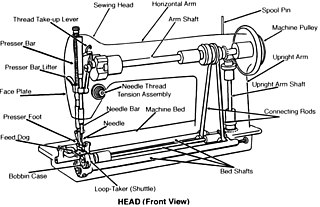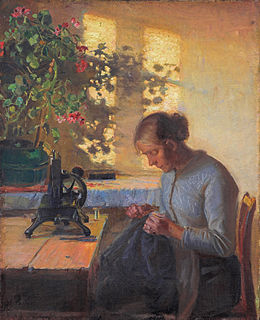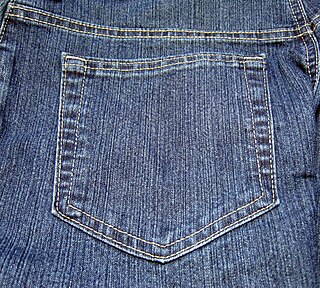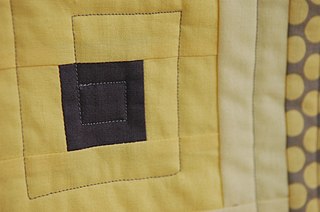
Quilting is the term given to the process of joining a minimum of three layers of fabric together either through stitching manually using a needle and thread, or mechanically with a sewing machine or specialised longarm quilting system. An array of stitches is passed through all layers of the fabric to create a three dimensional padded surface. The three layers are typically referred to as the top fabric or quilt top, batting or insulating material and the backing.

A sewing machine is a machine used to sew fabric and materials together with thread. Sewing machines were invented during the first Industrial Revolution to decrease the amount of manual sewing work performed in clothing companies. Since the invention of the first sewing machine, generally considered to have been the work of Englishman Thomas Saint in 1790, the sewing machine has greatly improved the efficiency and productivity of the clothing industry.

Appliqué is ornamental needlework in which pieces or patches of fabric in different shapes and patterns are sewn or stuck onto a larger piece to form a picture or pattern. It is commonly used as decoration, especially on garments. The technique is accomplished either by hand stitching or machine. Appliqué is commonly practised with textiles, but the term may be applied to similar techniques used on different materials. In the context of ceramics, for example, an appliqué is a separate piece of clay added to the primary work, generally for the purpose of decoration.

Sewing is the craft of fastening or attaching objects using stitches made with a sewing needle and thread. Sewing is one of the oldest of the textile arts, arising in the Paleolithic era. Before the invention of spinning yarn or weaving fabric, archaeologists believe Stone Age people across Europe and Asia sewed fur and leather clothing using bone, antler or ivory sewing-needles and "thread" made of various animal body parts including sinew, catgut, and veins.

A lockstitch is the most common mechanical stitch made by a sewing machine. The term "single needle stitching", often found on dress shirt labels, refers to lockstitch.

A pocket is a bag- or envelope-like receptacle either fastened to or inserted in an article of clothing to hold small items. Pockets are also attached to luggage, backpacks, and similar items. In older usage, a pocket was a separate small bag or pouch.

A hem in sewing is a garment finishing method, where the edge of a piece of cloth is folded and sewn to prevent unravelling of the fabric and to adjust the length of the piece in garments, such as at the end of the sleeve or the bottom of the garment.

In sewing and fashion design, a pattern is the template from which the parts of a garment are traced onto woven or knitted fabrics before being cut out and assembled. Patterns are usually made of paper, and are sometimes made of sturdier materials like paperboard or cardboard if they need to be more robust to withstand repeated use. The process of making or cutting patterns is sometimes compounded to the one-word Patternmaking, but it can also be written pattern(-)making or pattern cutting.

Buttonholes are reinforced holes in fabric that buttons pass through, allowing one piece of fabric to be secured to another. The raw edges of a buttonhole are usually finished with stitching. This may be done either by hand or by a sewing machine. Some forms of button, such as a frog, use a loop of cloth or rope instead of a buttonhole. Buttonholes can also refer to flowers worn in the lapel buttonhole of a coat or jacket, which are referred to simply as "buttonholes" or boutonnières.

A shank is a device for providing a small amount of space in between a garment and a button. Shanks are necessary to provide space for fabric to sit in between the button and the garment when the garment is buttoned. Shanks also allow a garment to hang and drape nicely.

In sewing, to tack or baste is to sew quick, temporary stitches that will later be removed. Tacking is used for a variety of reasons, such as holding a seam in place until it is sewn properly, or transferring pattern markings onto the garment. Tacking is typically sewn using a specialised tacking thread, which may snap easily in order for it to be easily removed from the garment when necessary.
In knitting, steeking is a shortcut used to knit garments such as sweaters in the round without interruption for openings or sleeves until the end. After completing a tube, a straight line is cut along the center of a column of stitches, in order to make room for an opening or place to attach another piece. The steek itself is a bridge of extra stitches, in which the cut is made, and is usually 6-10 stitches wide. This technique was developed by the knitters of Shetland and is particularly associated with Fair Isle sweaters, although it can be used for solid colors as well.

The straight or running stitch is the basic stitch in hand-sewing and embroidery, on which all other forms of sewing are based. The stitch is worked by passing the needle in and out of the fabric at a regular distance. All other stitches are created by varying the straight stitch in length, spacing, and direction.

In sewing, a tuck is a fold or pleat in fabric that is sewn or fastened in place.
Sewing is the craft of fastening or attaching objects using stitches made with needle and thread. Sewing is one of the oldest of the textile arts, arising in the Paleolithic Era. Although usually associated with clothing and household linens, sewing is used in a variety of crafts and industries, including shoemaking, upholstery, sailmaking, bookbinding and the manufacturing of some kinds of sporting goods. Sewing is the fundamental process underlying a variety of textile arts and crafts, including embroidery, tapestry, quilting, appliqué and patchwork.

In sewing, a seam is the join where two or more layers of fabric, leather, or other materials are held together with stitches. Prior to the invention of the sewing machine, all sewing was done by hand. Seams in modern mass-produced household textiles, sporting goods, and ready-to-wear clothing are sewn by computerized machines, while home shoemaking, dressmaking, quilting, crafts, haute couture and tailoring may use a combination of hand and machine sewing.

A blind stitch in sewing is a method of joining two pieces of fabric so that the stitch thread is invisible, or nearly invisible. Blind stitching hides stitching under folded edges; therefore, this type of stitch can be used to create a blind hem or to join two folded edges together.

A presser foot is an attachment used with sewing machines to hold fabric flat as it is fed through the machine and stitched. Sewing machines have feed dogs in the bed of the machine to provide traction and move the fabric as it is fed through the machine, while the sewer provides extra support for the fabric by guiding it with one hand. A presser foot keeps the fabric flat so that it does not rise and fall with the needle and pucker as it is stitched. When especially thick workpieces are to be sewn, such as quilts, a specialized attachment called a walking foot is often used rather than a presser foot.

A coverstitch is formed by two or more needles which add straight stitches to the fabric and a looper thread on the opposite side of the fabric that zig-zags between the straight stitches. A coverstitch results in parallel lines of straight stitches on one side of the fabric and an overcast stitch on the reverse side. It is widely used in garment construction, particularly for attaching trims and flat seaming where the raw edges can be finished in the same operation as forming the seam.

















